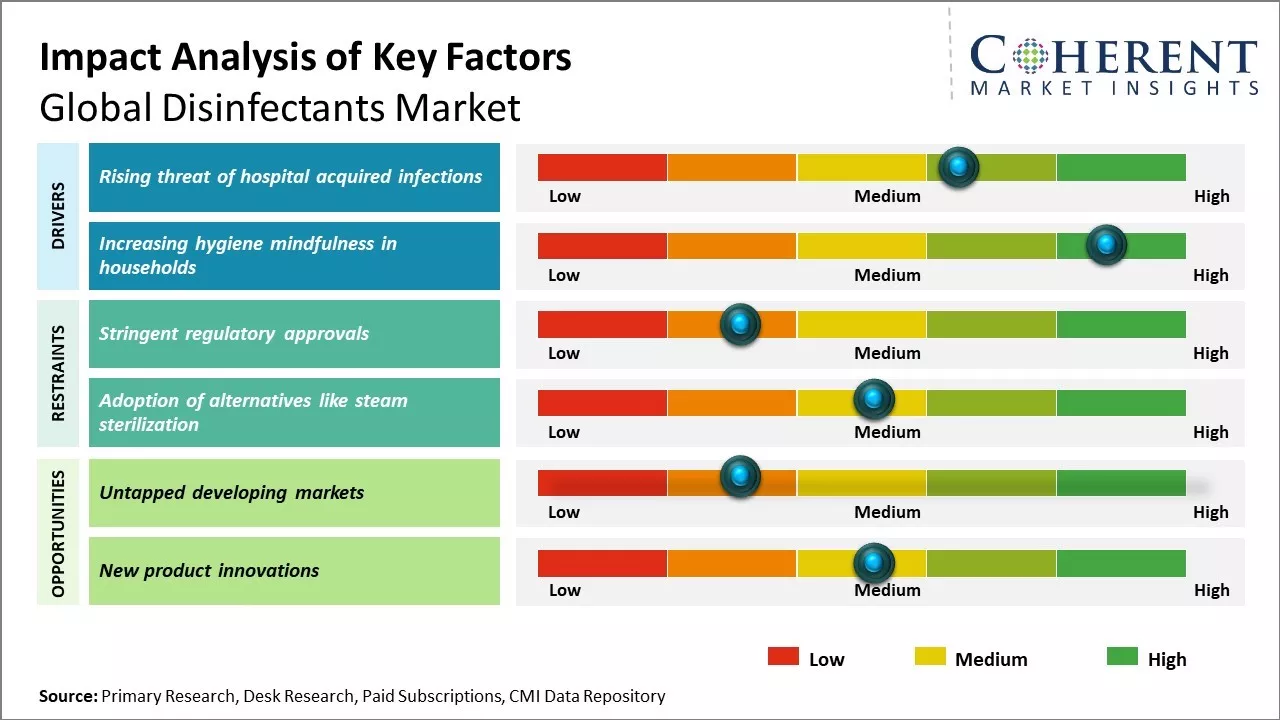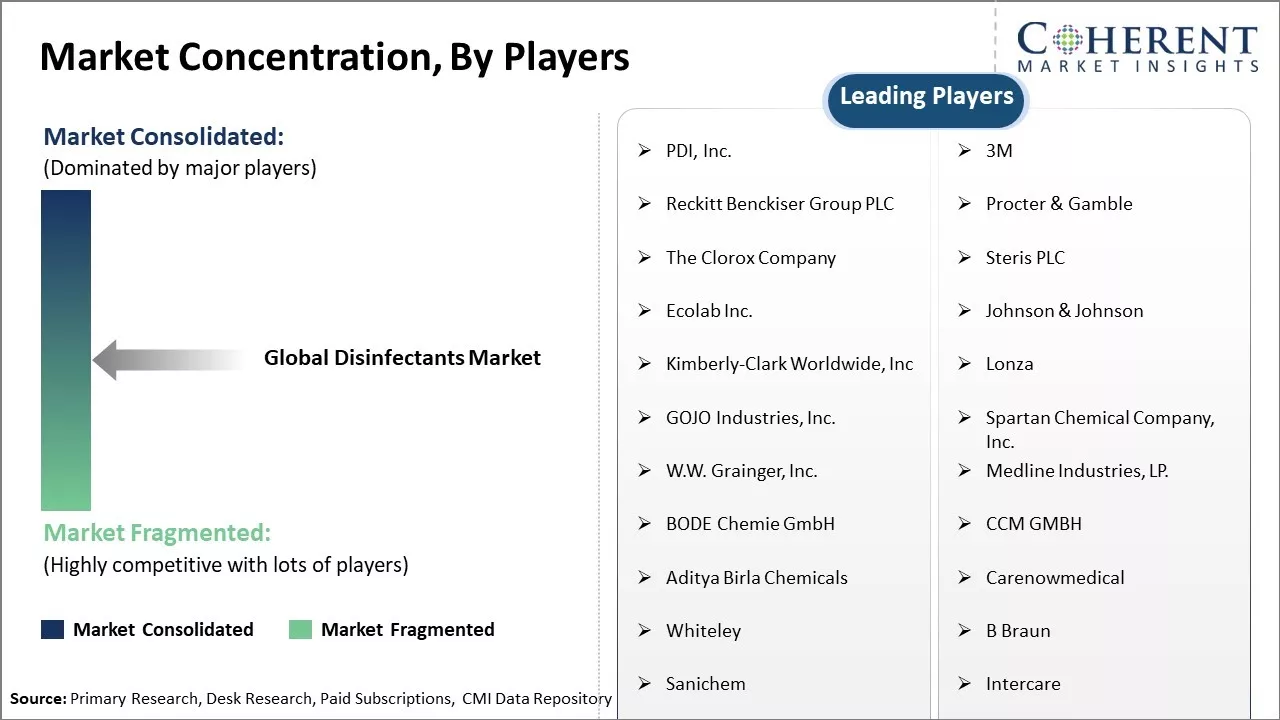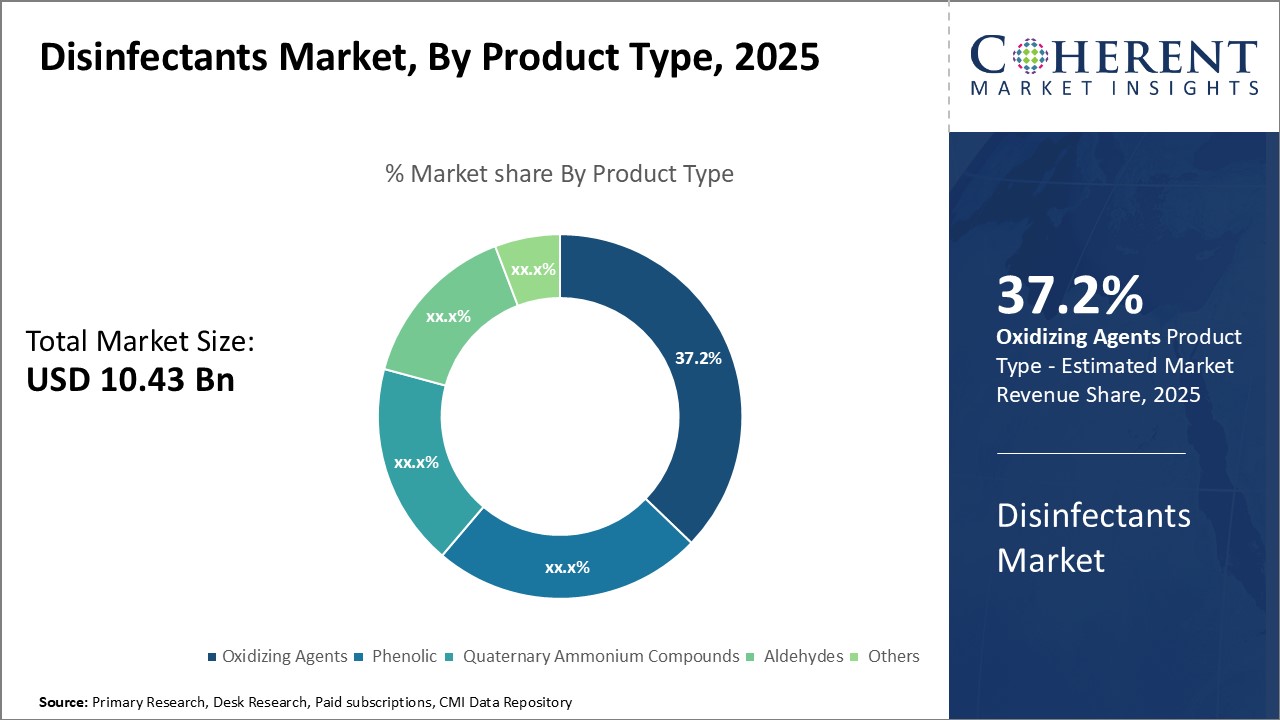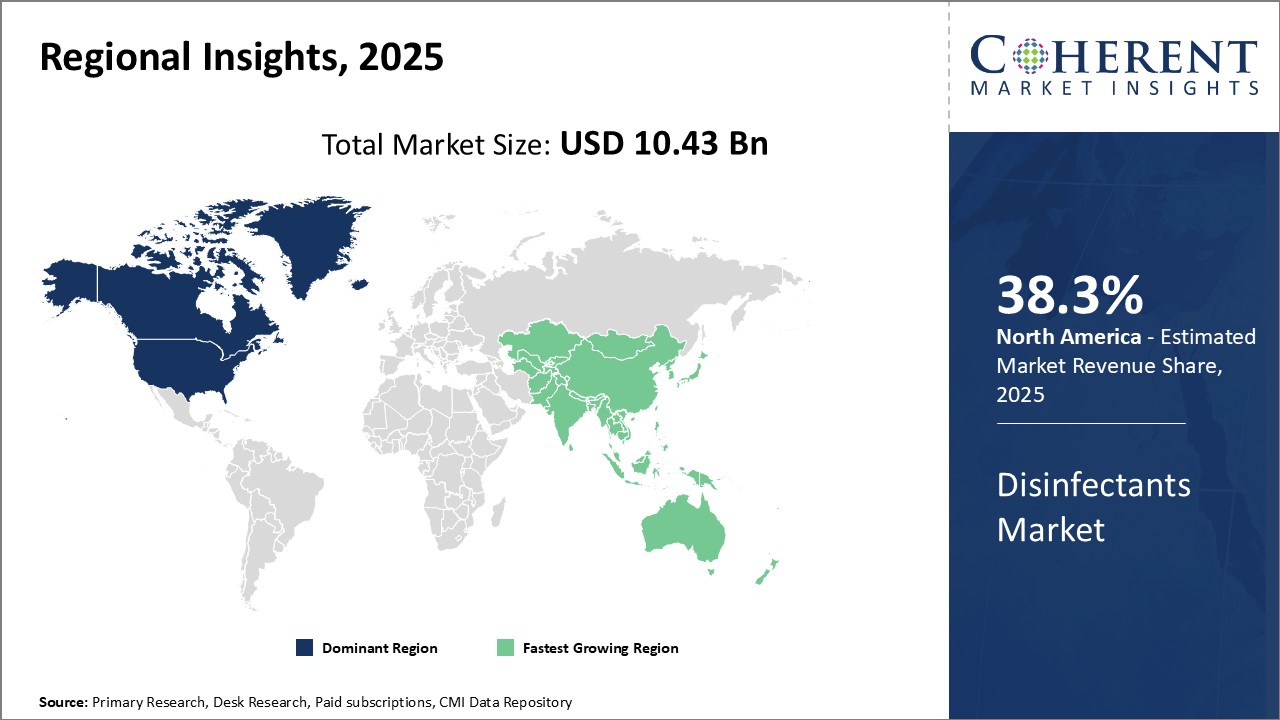The disinfectants market is estimated to be valued at USD 10.43 Bn in 2025 and is expected to reach USD 17.09 Bn by 2032, exhibiting a compound annual growth rate (CAGR) of 7.3% from 2025 to 2032.

Discover market dynamics shaping the industry: Download Free Sample
The global disinfectants market is expected to witness significant growth over the forecast period. Increased consumer awareness about health and hygiene and ongoing innovations led by key players to develop sustainable and eco-friendly disinfectants are some key factors expected to drive the demand. Additionally, rising prevalence of hospital acquired infections and implementation of various government regulations regarding the use of disinfectants in healthcare settings will further aid the market expansion. Growing requirement of surface disinfectants across the food processing and hospitality industries due to the COVID-19 pandemic is also projected to promote the business outlook. However, the availability of alternate cleaning chemicals and strict environmental & safety regulations for certain chemically-based products may hamper the revenue index of disinfectants over the coming years.
Rising threat of hospital acquired infections
The growing risk of hospital acquired infections among patients has compelled healthcare facilities to pay greater attention to disinfection and sanitization practices. Constant influx of patients combined with their susceptibility to several ailments increases the chances of spreading infections within hospitals. Even a slight oversight in sanitizing routine can have devastating consequences. In recent times, many medical institutes have reported outbreaks of drug-resistant pathogens that are proving hard to treat. This has emerged as a serious concern worldwide. The need to bolster hygienic standards and boost disinfection protocols has prompted hospitals to extensively utilize disinfectants in all possible areas where bacterial or viral transmissions may occur. From high touch surfaces in operating rooms and ICUs to equipment handled by numerous persons each day, healthcare providers have widened the application of disinfectants. This is positively impacting the sales of various disinfectant types meant for surface disinfection as well as instrument disinfection in the hospital environment. As keeping healthcare facilities infection-free grows more crucial than ever before.

Get actionable strategies to beat competition: Download Free Sample
Increasing hygiene mindfulness in households
While the COVID-19 pandemic has made cleanliness and sanitization a priority in all public spaces, it has also raised awareness about personal hygiene among citizens. People have become far more attentive to germ transmission and the role of regular disinfection in containing the spread of infectious diseases. Countless lives were lost due to neglecting hygiene during the worst outbreaks. This unfortunate experience has instilled diligence towards maintaining clean home environments. From frequently sanitizing high-touch surfaces to practicing good hand hygiene, individuals have incorporated disinfection routines in their daily lives. Consequently, the sales of household disinfectants has picked up significantly as people clean more meticulously. Moreover, concerns around the next health crisis have made preventive disinfection a regular household chore for many. As long as hygiene remains a non-negotiable aspect of self-care, can expect continued rise in domestic usage of disinfectants for multi-purpose cleaning and disinfecting of homes, thereby driving the overall market growth.
Key Takeaways of Analyst:
The disinfectants market is expected to grow steadily driven by the ongoing COVID-19 pandemic and rising health and hygiene awareness worldwide. Stringent regulations regarding the use of disinfectants in healthcare and food processing facilities will further aid market expansion.
Asia Pacific currently dominates the global demand due to its huge population and increasing healthcare expenditure in nations like India and China. North America will likely remain the fastest growing regional market with the U.S. spearheading product innovation and stringent protocols to curb hospital acquired infections. However, environmental and health concerns over the toxicity of certain chemical disinfectants may hamper industry revenue to some extent in the long run.
Non-toxic botanical and plant-based alternatives are emerging as viable substitutes and are expected to gain more traction going forward. The shift towards more sustainable and environment-friendly disinfecting solutions opens new avenues for manufacturers. Short product shelf-life and issues regarding supply chain disruptions remain key challenges for market participants.
Market Challenges: Stringent regulatory approvals
Stringent regulatory approvals is one of the major factors restraining the growth of the global disinfectants market. Disinfectants are chemicals that are used to kill microorganisms and prevent the spread of infections. However, these chemicals can also pose certain health risks if not used properly. Various governments across the globe have implemented strict norms and guidelines for approving new disinfectant products as well as regulating the existing ones. This is done to ensure the safety of consumers who will be using these chemicals. The approval process involves thorough clinical testing and trial phases that can take several years. Manufacturers need to provide detailed documentation about the product formulation, intended use, potential side effects, safety precautions etc. to the regulatory bodies like EPA and FDA. Obtaining all the necessary certifications and clearances is a long drawn and expensive process.
Market Opportunities: Untapped developing markets
Developing markets offer large untapped potential for growth in the global disinfectants market. These regions have massive populations but historically lower consumption levels of disinfectants compared to developed economies. As hygiene awareness and standards of living rise across developing nations, demand for disinfectants is projected to rapidly increase to service these needs. Many developing nations in regions like South and Southeast Asia, Latin America, and Africa are experiencing significant economic development which is lifting incomes. As people can afford more, they also demand better healthcare, public sanitation and personal hygiene products. They look for safe and effective ways to prevent the spread of illnesses in homes, hospitals and public spaces. This growing focus on hygiene presents a major opportunity for disinfectant producers to introduce new product ranges tailored for these markets and budgets.

Discover high revenue pocket segments and roadmap to it: Download Free Sample
Insights, by Product Type: Strong antimicrobial properties drive the segment growth
In terms of product type, oxidizing agents is expected to contribute 37.2% share of the market in 2025. Oxidizing agents represent the largest product segment in the disinfectants market. These chemicals work by oxidizing cell components of microbes like bacteria, viruses, and fungi, disrupting their structures and metabolisms. Common oxidizing agents used in disinfectants include hydrogen peroxide, peracetic acid, and sodium hypochlorite. What gives oxidizing agents an edge over other product types is their ability to kill a wide range of pathogens rapidly through disruption of their DNA, proteins, and cell membranes. This broad-spectrum antimicrobial activity makes them well-suited for applications with high contamination risks like hospital surfaces, medical devices, and food processing equipment. Oxidizing agents' effectiveness is backed by regulatory approvals and claims against dangerous pathogens. For instance, hydrogen peroxide is EPA-approved to eliminate C. difficile and norovirus, two leading causes of hospital-acquired infections. Sodium hypochlorite solutions like bleach have proven potency against vaccine-preventable diseases and foodborne illnesses caused by Salmonella, E. coli and Listeria. Such third-party validation helps users select oxidizing agents confidently for disinfection needs. Their speed and breadth of action also enable less contact time compared to other chemistries. Being inorganic compounds, oxidizing agents break down into oxygen and water after use, leaving no harmful residues. This makes them preferable for applications where residual toxins can perpetuate contamination issues. Healthcare facilities in particular prioritize products delivering high disinfection assurance without toxic remnants.
Insights, by End-use Industry: Stringent infection control requirements drive the segment growth
In terms of end-use industry, healthcare is expected to contribute 34.2% share of the market in 2025. The healthcare industry accounts for the largest share of the disinfectants market by end-use industry. Hospitals, nursing homes, medical device manufacturers, and other healthcare providers rely heavily on proper disinfection to curb the spread of antimicrobial resistance. However, pathogenic bacteria and viruses continue evolving, necessitating more advanced disinfection protocols. Regulatory bodies like the CDC intensify guidelines on cleaning and disinfection practices at healthcare centers. They publish extensive lists of EPA-approved disinfectants proven effective against deadly pathogens. Failure to adhere to such lists can result in penalties, litigation, or loss of accreditation. As research links more diseases and infections to surfaces, healthcare disinfection receives growing scrutiny. Moreover, immunocompromised patients are at especially high risk of severe illness from common infections. Disinfection also affects providers' reimbursement and hospitals' patient safety rankings—two important performance metrics. Diseases acquired during medical care threaten patient outcomes and trust in providers. Meanwhile, awareness of hospital cleanliness and infection rates influence consumer choice. This makes disinfection a priority to safeguard patients and maintain revenue. Such stringent regulations and quality imperatives drive the healthcare sector to adopt scientifically-validated, advanced disinfectants. Their needs for broad-spectrum, fast-acting products to disinfect diverse surfaces and materials further boost demand.

Need a Different Region or Segment? Download Free Sample
North America has established itself as the dominant regional market for disinfectants. The region is expected to account for 38.3% of the market share in 2025. The region accounts for the largest share of the global market owing to a strong demand from key end-use industries such as healthcare and food processing. North America has a highly developed healthcare infrastructure with the presence of many hospitals, clinics, and long-term care facilities that require robust disinfection practices. This contributes significantly to the high adoption of disinfectants. Additionally, stringent regulations pertaining to hygiene and infection control across diverse sectors such as healthcare, food, and hospitality bolster market growth. Regulatory agencies like the FDA have guidelines in place to ensure effective disinfection at medical facilities, restaurants, schools, and other public spaces. Compliance to such norms is directly driving greater consumption of disinfectant chemicals and solutions. Growing health awareness among population regarding hygiene maintenance during epidemics and pandemics has further augmented market prospects over the last few years. Manufacturers are launching innovative products catering to these demands, which bodes well for the industry.
Among other regions, Asia Pacific displays high potential as the fastest growing market. Rapid industrialization, rising income levels, increasing health expenditure, and urbanization are key macroeconomic factors prompting the demand upswing across developing nations such as India and China. Asia Pacific hosts a robust chemicals industry which churns out affordable disinfectants. Foreign investments coupled with supportive free trade agreements are helping lower trade barriers and boost cross-border commerce. These favorable conditions will allow the Asia Pacific market to increase its participation in the global trade over the coming years.
Disinfectants Market Report Coverage
| Report Coverage | Details | ||
|---|---|---|---|
| Base Year: | 2024 | Market Size in 2025: | USD 10.43 Bn |
| Historical Data for: | 2020 To 2024 | Forecast Period: | 2025 To 2032 |
| Forecast Period 2025 to 2032 CAGR: | 7.3% | 2032 Value Projection: | USD 17.09 Bn |
| Geographies covered: |
|
||
| Segments covered: |
|
||
| Companies covered: |
PDI, Inc., 3M, Reckitt Benckiser Group PLC, Procter & Gamble , The Clorox Company , Steris PLC, Ecolab Inc. , Johnson & Johnson, Kimberly-Clark Worldwide, Inc, Lonza, GOJO Industries, Inc., Spartan Chemical Company, Inc., W.W. Grainger, Inc., Medline Industries, LP., BODE Chemie GmbH, CCM GMBH, Aditya Birla Chemicals, Carenowmedical, Whiteley , B Braun, Sanichem, and Intercare |
||
| Growth Drivers: |
|
||
| Restraints & Challenges: |
|
||
Uncover macros and micros vetted on 75+ parameters: Get instant access to report
*Definition: The disinfectants market involves the manufacturing, distribution and sales of various types of disinfectant chemical products that are used to kill or inhibit the growth of microorganisms on inanimate surfaces. Major product types include alcohol disinfectants, disinfectant sprays and wipes, disinfectant liquids, sanitizers, and others. These disinfectants are used across various end-use industries like healthcare facilities, household, commercial spaces, food and beverage industry and others.
Share
Share
About Author
Yash Doshi is a Senior Management Consultant. He has 12+ years of experience in conducting research and handling consulting projects across verticals in APAC, EMEA, and the Americas.
He brings strong acumen in helping chemical companies navigate complex challenges and identify growth opportunities. He has deep expertise across the chemicals value chain, including commodity, specialty and fine chemicals, plastics and polymers, and petrochemicals. Yash is a sought-after speaker at industry conferences and contributes to various publications on topics related commodity, specialty and fine chemicals, plastics and polymers, and petrochemicals.
Missing comfort of reading report in your local language? Find your preferred language :
Transform your Strategy with Exclusive Trending Reports :
Frequently Asked Questions
Joining thousands of companies around the world committed to making the Excellent Business Solutions.
View All Our Clients